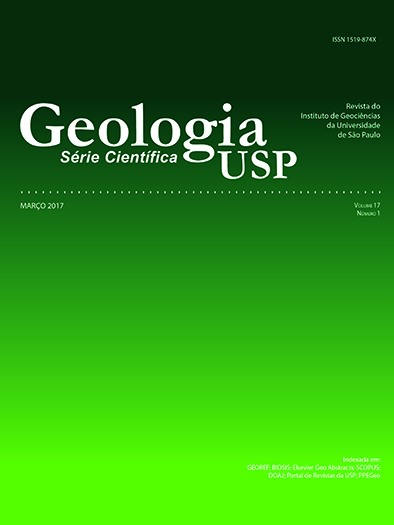Facies analysis and petrography of a section of the Crato Member in Nova Olinda (CE): contributions to the depositional and diagenetic history of the Late Aptian in the Araripe Basin
DOI:
https://doi.org/10.11606/issn.2316-9095.v17-319Keywords:
Araripe Basin, Crato Member, Facies analysis, Diagenesis.Abstract
The Crato Member is one of the most important stratigraphic units of the Araripe Basin due to its fossil content, its context analogous to the Brazilian “Pre-Salt Layers”, and its use as covering stone. Facies and petrographic analyses were combined in our study of a section of the Crato Member in Nova Olinda (State of Ceará, Brazil), aiming to investigate its depositional and diagenetic history. Thus, we analysed the faciology of a continuous columnar section ca. 70 m thick, and collected 13 samples of limestones, sandstones and evaporites. The collected samples were analysed by optical petrography. Five depositional facies were described: massive marly mudstone (Lm), laminated calcilutite (Cl), almost-massive arenite (Am), siltite with climbing ripple lamination (Scc), and columnar evaporite (Ec). The thickest and recurrent facies were interpreted as lacustrine (Lm, Cl), followed by alluvial successions (Am, Scc) interbedded between the lacustrine ones. The succession finishes with faciological evidences for extreme arid conditions (Ec) reached at the end of the interval. The petrography, here focused on rocks of facies Cl, Aqm, and Scc, reinforces the idea of an arid lacustrine system for the local Aptian Stage, and that this system was fed by immature alluvial flows coming from close source areas. Particularly, the very low grade of mechanical compaction and incipient cementation of the terrigenous rocks suggest that the succession as a whole was barely affected by diagenesis after burial that, for this reason, was shallow. The resemblance of the Crato Member terrigenous intervals to the ones of the final of the underlying Barbalha Formation suggests contemporaneity and transitional retrograding passage from one unit to another.
Downloads
Downloads
Published
Issue
Section
License
Authors who publish in this journal shall comply with the following terms:
- Authors keep their copyright and grant to Geologia USP: Série Científica the right of first publication, with the paper under the Creative Commons BY-NC-SA license (summary of the license: https://creativecommons.org/licenses/by-nc-sa/4.0 | full text of the license: https://creativecommons.org/licenses/by-nc-sa/4.0/legalcode) that allows the non-commercial sharing of the paper and granting the proper copyrights of the first publication in this journal.
- Authors are authorized to take additional contracts separately, for non-exclusive distribution of the version of the paper published in this journal (publish in institutional repository or as a book chapter), granting the proper copyrights of first publication in this journal.
- Authors are allowed and encouraged to publish and distribute their paper online (in institutional repositories or their personal page) at any point before or during the editorial process, since this can generate productive changes as well as increase the impact and citation of the published paper (See The effect of Open Access and downloads on citation impact).





